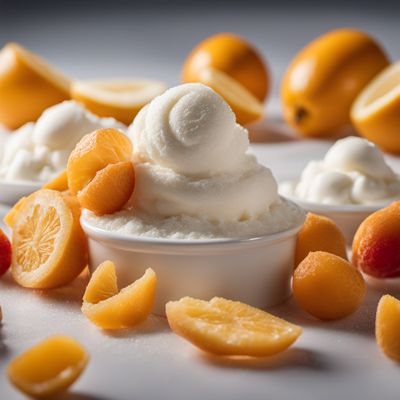
Ingredient
Water-based ice creams
Cool Delights: Refreshing Water-Based Ice Creams
Water-based ice creams are made with a combination of water, sugar, and various flavorings to create a frozen treat that is dairy-free and lower in fat. They have a smooth and creamy texture, similar to traditional ice creams, and come in a multitude of flavors, from fruity sorbets to indulgent chocolate creations. Whether enjoyed in a cone, cup, or as a base for creative desserts, water-based ice creams are a delightful way to beat the heat.
Origins and history
The exact origins of water-based ice creams are unclear, but frozen desserts have been enjoyed for centuries in different cultures around the world. Ancient civilizations, such as the Chinese, Persians, and Romans, experimented with freezing sweetened liquids to create icy treats. Over time, various techniques and ingredients were developed to refine the art of making frozen desserts. Today, water-based ice creams are enjoyed globally, with each culture adding its own unique twist to the recipes.
Nutritional information
Water-based ice creams are generally lower in calories and fat compared to dairy-based ice creams. They are often made with natural fruit juices, purees, or extracts, providing a range of vitamins and antioxidants. The exact nutritional content varies depending on the specific recipe and brand. It is important to check the label for any added sugars or artificial ingredients. Water-based ice creams are a great option for individuals with lactose intolerance or those looking for a lighter frozen treat. The calorie content can range from 70 to 150 calories per serving, depending on the flavor and brand.
How to select
When selecting water-based ice creams, read the ingredient list to ensure that it is free from any allergens or artificial additives. Look for brands that use natural flavors and minimal added sugars. Consider the texture and consistency of the ice cream, as some may be smoother and creamier than others. Opt for options that have a good balance of sweetness and flavor intensity. It is also important to check the expiration date to ensure freshness.
Storage recommendations
To maintain the quality and prevent freezer burn, store water-based ice creams in airtight containers in the freezer. Avoid frequent thawing and refreezing, as this can affect the texture and taste. It is best to consume the ice cream within a few weeks of purchase for optimal freshness. If the ice cream becomes too hard, let it sit at room temperature for a few minutes to soften before serving.
How to produce
Water-based ice creams are typically produced by commercial ice cream manufacturers using specialized equipment and processes. However, for those who enjoy making homemade frozen treats, there are numerous recipes available online or in cookbooks. These recipes often require a blender or ice cream maker to achieve the desired texture and consistency. Experiment with different flavors and combinations to create your own unique water-based ice cream creations.
Preparation tips
Water-based ice creams can be enjoyed on their own or used as a base for creative desserts. They can be served in cones, cups, or transformed into refreshing floats or milkshakes. Water-based ice creams are also commonly used as a topping for fruit salads, pies, or cakes. They can be layered with other flavors or used to create unique ice cream sandwiches. The possibilities are endless when it comes to incorporating water-based ice creams into your favorite desserts.
Culinary uses
Water-based ice creams are commonly used in a variety of frozen desserts, such as sorbets, granitas, and Italian ice. They are also a popular choice for individuals with dietary restrictions or preferences, such as vegans or those who are lactose intolerant. Water-based ice creams can be found in supermarkets, specialty dessert shops, and ice cream parlors around the world.

